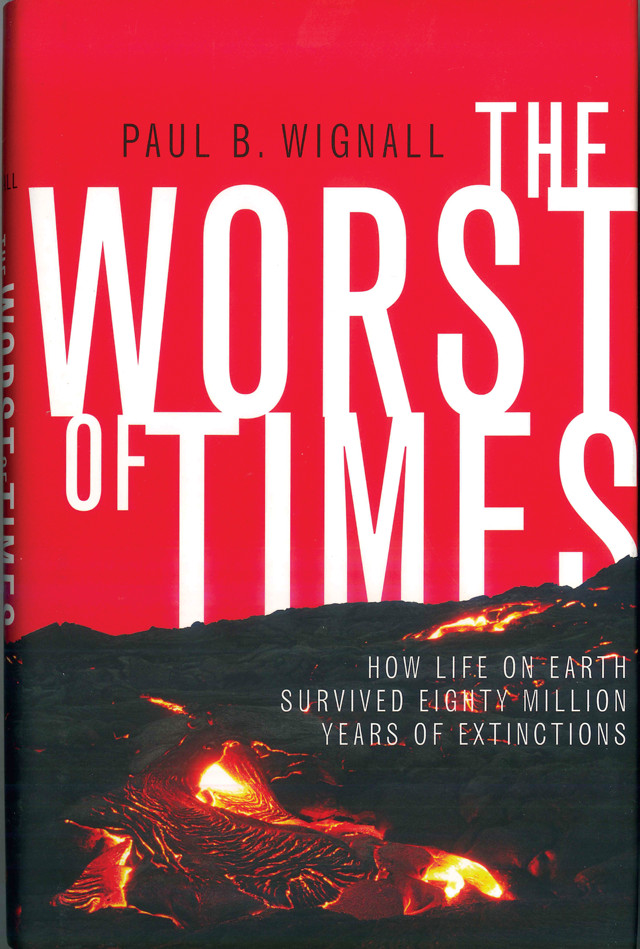
by Callan Bentley Wednesday, January 25, 2017

"The Worst of Times: How Life on Earth Survived Eighty Million Years of Extinctions," by Paul B. Wignall, Princeton University Press, May 2017, paperback, 978-0691176024. (Hardcover, 2015, 978-0691142098).
Every reader of this magazine knows something about mass extinctions. But few of us know as much as Paul B. Wignall, a professor of paleoenvironments at the University of Leeds in England who studies mass extinctions. In 1997, he co-authored with Anthony Hallam a scholarly volume titled “Mass Extinctions and their Aftermath.” Now, his first book aimed at a popular audience, “The Worst of Times: How Life on Earth Survived Eighty Million Years of Extinctions,” has been issued in paperback.
It has an unusual focus: a period of time from the mid-Permian to the mid-Jurassic that Wignall describes as “the worst 80 million years in Earth’s history.” This nameless span includes two of the “Big Five” mass extinction events that are familiar to students of historical geology. But it also includes four less famous crises that share key characteristics with the end-Permian and end-Triassic events. What unites these events is that they all occurred during the existence of the supercontinent Pangea, and they are all associated with the eruption of large igneous provinces (LIPs).
The circumstances involved in each of the crises are similar: Magma erupts through layers of coal, black shale or other rock loaded with volatile compounds like halogens and greenhouse gases, and when these sedimentary rocks are cooked by the molten rock, the gases escape, contributing to atmospheric ozone depletion and global warming. Warmer oceans circulate more sluggishly, and oxygen is soon depleted from the stagnant waters. This creates conditions for a distinctive set of anoxic sediments, peppered with little raspberry-shaped nuggets of pyrite, to form. In each event, carbon isotope ratios also take a wild jag, indicating major changes in carbon cycling in the Earth system. Wignall explores possibilities for what those changes may have been, with the caveat that different types of change can produce similar variations in carbon isotope signals.
Wignall is greatly interested in the details of these events, so while this book is written for a nonspecialist audience, he goes into the weeds somewhat to explore the evidence of what went awry in the Earth system during these six events to cause extinctions.
Reading “The Worst of Times,” you’ll learn in excruciating detail about the cavalcade of organisms that went extinct and when, as well as about other groups that only took a hit before recovering and evolving in the aftermath. I like fossil critters as much as the next geek, and these minutiae make the learning experience more comprehensive, but only a diehard extinction-loving paleontologist could call it fun. Some clever graphics could have remedied this. A full-color timeline showing the shifting cast of characters and the LIP eruptions across the seven slices of time punctuated by the mass extinctions would have been appreciated.
Despite this critique, Wignall does well with words. His discourse covers a wide variety of evidence, ranging from paleontology to oceanography to isotope geochemistry. He reveals the cascade of effects implicated in triggering fundamental destabilizations of the biosphere, tracing them out in relatively plain language. And in this effort, he does provide a couple of handy, easy-to-follow flowcharts showing how the many different variables are thought to have interacted in each episode, wrecking the ecosystem. He is also skeptical and critical, treating multiple competing hypotheses equally and stating frankly when evidence is lacking on a critical point of understanding. Following Wignall’s train of thought thus allows readers real insight into the way that professional geoscientists approach ancient “whodunits?” like the end-Permian extinction.
Interestingly, despite the blame they receive for causing mass die-offs while Pangea was assembled, there were LIPs that erupted after the supercontinent broke up, but which are not associated with mass extinctions. The Deccan Traps in India are a notable exception, although their role in triggering the end-Cretaceous extinction is uncertain, considering the big impact that occurred at the same time on the other side of the world. But there are plenty of other examples of voluminous and rapid LIPs that left fewer corpses in their wake. Wignall posits some reasons why our modern dispersed flotilla of continents may be nimbler at weathering volcanic crises than a single supercontinent. However, much remains unknown about the exact roles the many different factors play.
Wignall concludes the book by citing the eruptions of LIPs as an ancient analogue for the modern anthropogenic release of carbon dioxide to the atmosphere. Although it’s an imperfect analogy, the rock record shows that novel introductions of these gases have coincided with nasty moments throughout life’s history. That alone should be sufficient motivation for learning as much as we can about them.
© 2008-2021. All rights reserved. Any copying, redistribution or retransmission of any of the contents of this service without the expressed written permission of the American Geosciences Institute is expressly prohibited. Click here for all copyright requests.